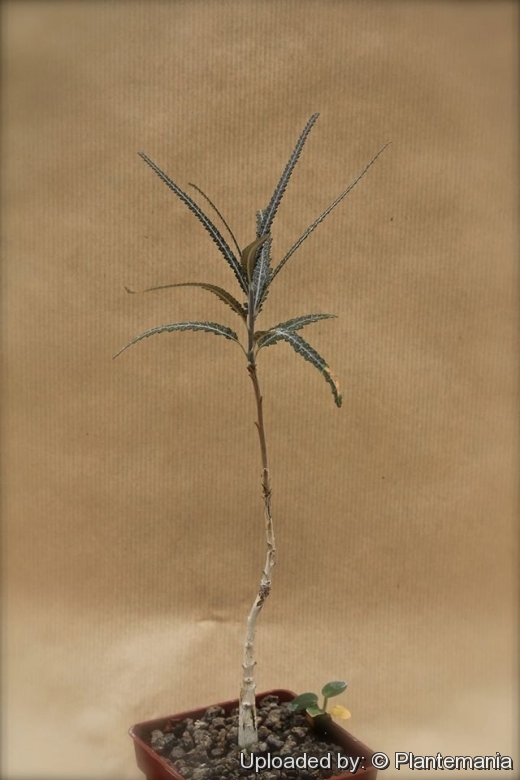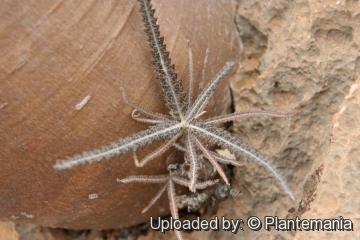
Boswellia elongata Photo by: © Plantemania
A juvenile specimen with still simple leaves.
Origin and Habitat: Boswellia elongataSN|33360]]SN|33360]] is endemic to the Socotra island, Yemen.
Altitude range: 100–650 metres above sea level.
Habitat and Ecology: It grows in dry, semi-deciduous woodland and less commonly in succulent shrubland often accompanied by low-growing Buxus hildebrandtii. B. elongata is one of the most adaptable species under diverse conditions. It has a scattered and extremely fragmented distribution with many populations not regenerating and relict in nature. This pattern of distribution strongly suggests a decline in the extent and quality of its habitat. Boswellia elongataSN|33360]]SN|33360]] is exploited for the collection of incense that is used almost exclusively by the local population.
Synonyms:
Common Names include:
ENGLISH: frankincense tree, Socotran Frankincense tree
Description: Socotran Frankincense trees (Boswellia elongata), one of seven endemic species found on Socotra, is a medium to large deciduous pachycaul tree 6-8 metres tall with diverse forms and intricate webs of branching, appearing as one of the very distinctive plants of Socotra. The long slender leaves, are simple when young turning pinnate and feathery with age. New growth has an intricate lacy texture like a spiderweb. The colour of the leaves varies from grey, to purple, to light green with pale undersides depending on the environment. An incense resin can be collected from Boswellia elongataSN|33361]]SN|33360]], the aromatic sap often forms beads along the trunk making for easy harvest. However its gum-resin is not so penetratingly fragrant as Boswellia ameeroSN|33360]]SN|33361]]. This is a favourite of the rare frankincense and very good topic for bonsai lovers.
Stem:* Tree trunk erect 6 to 8 m tall, trunk 0.8-1 m in diameter with a strongly flaking yellowish, pale brown or bronze, peeling bark. Branches thick swollen, spreading more or less horizontal and wavy. In cultivation under shelter, usually does not exceed 2.20 m.
Leaves: Simple when young turning pinnate with age, 15-30 cm long, grey-green, dark green to purple-grey with pale undersides strongly incised and elongated. Adult plants with simple leaves are possibly hybrids with Boswellia popoviana.
Flowers: Flowers in elegant panicles (bunches), fragrant, white to yellowish-green with a pink centre.
Bibliography: Major references and further lectrures
1) Miller, A. 2004. Boswellia elongata. The IUCN Red List of Threatened Species 2004 e.T30415A9546667. httpdx.doi.org10.2305IUCN.UK.2004.RLTS.T30415A9546667.en. Downloaded on 22 December 2016.
2) Miller, A.G. “List of Socotran endemics with conservation status.” Revised November 1991 (unpublished). 1992.
3) Miller, A.G. “Completed data collection forms and comments concerning the threatened trees of Socotra and Yemen.” 1997.
4) Oldfield, S., Lusty, C. and MacKinven, A. (compilers). “The World List of Threatened Trees.” World Conservation Press, Cambridge, UK. 1998.
5) Anthony G. Miller, Miranda Morris “Ethnoflora of the Soqotra Archipelago” Royal Botanic Garden Edinburgh, 01 January 2004
6) D Brian Doe “Socotra: Island of Tranquillity” Immel, 1992
7) by Jason Eslamieh “Cultivation of Boswellia, Sacred Trees of Frankincense!” 2011
 A seedling growing close to the caudex of Adenium socotranum. Socotra. Photo by: © Plantemania
A seedling growing close to the caudex of Adenium socotranum. Socotra. Photo by: © PlantemaniaSend a photo of this plant.The gallery now contains thousands of pictures, however it is possible to do even more. We are, of course, seeking photos of species not yet shown in the gallery but not only that, we are also looking for better pictures than those already present.
Read More... Cultivation and Propagation: The size and structure of the plant as a whole was greatly influenced by growing conditions, making the plant a short and compact bonsai like caudiciform or a more normal bush or small tree. It is a beautiful container plant, and it seems to like the container as much as being planted in the ground. It will be an indoor bonsai in all but the warmest climates.
Light requirements. Needs lots of light and fresh air.
Water requirements. Keep warm and moist at winter, as the winters on Socotra. But reduce water, especially when kept cool. Increase water during growing and blooming periods. The total watering needed is similar to other succulents, and it will lose leaves if overwatered.
Fertilization: Feed monthly during spring and summer with liquid bonsai fertilizer.
Temperature requirements: Keep in a bright location in winter (minimum temperature 12-15° C). However, in the winter, keeping it cool gives the plant a needed rest. In summer, if possible, move outdoors to a sunny or partly shaded location.
Maintenance: It has a large caudex with few short thin branches and do not need a heavy pruning after the plant's rest period as requested by other species. Eventually pruning should be kept to a minimum.
Repotting: Root prune and repot every two years, after the winter rest period, in a mix of 2 parts bonsai soil, 2 parts peat, and one part sand. Can tolerate being pot-bound.
Propagation: It is possible to root cuttings.
Propagation: Usually by seeds. It can also propagated by cutting of branch or stem rooted in a sand-peat mix. (Wait until 2-3 day before you plant. It will reduce rot.)***












